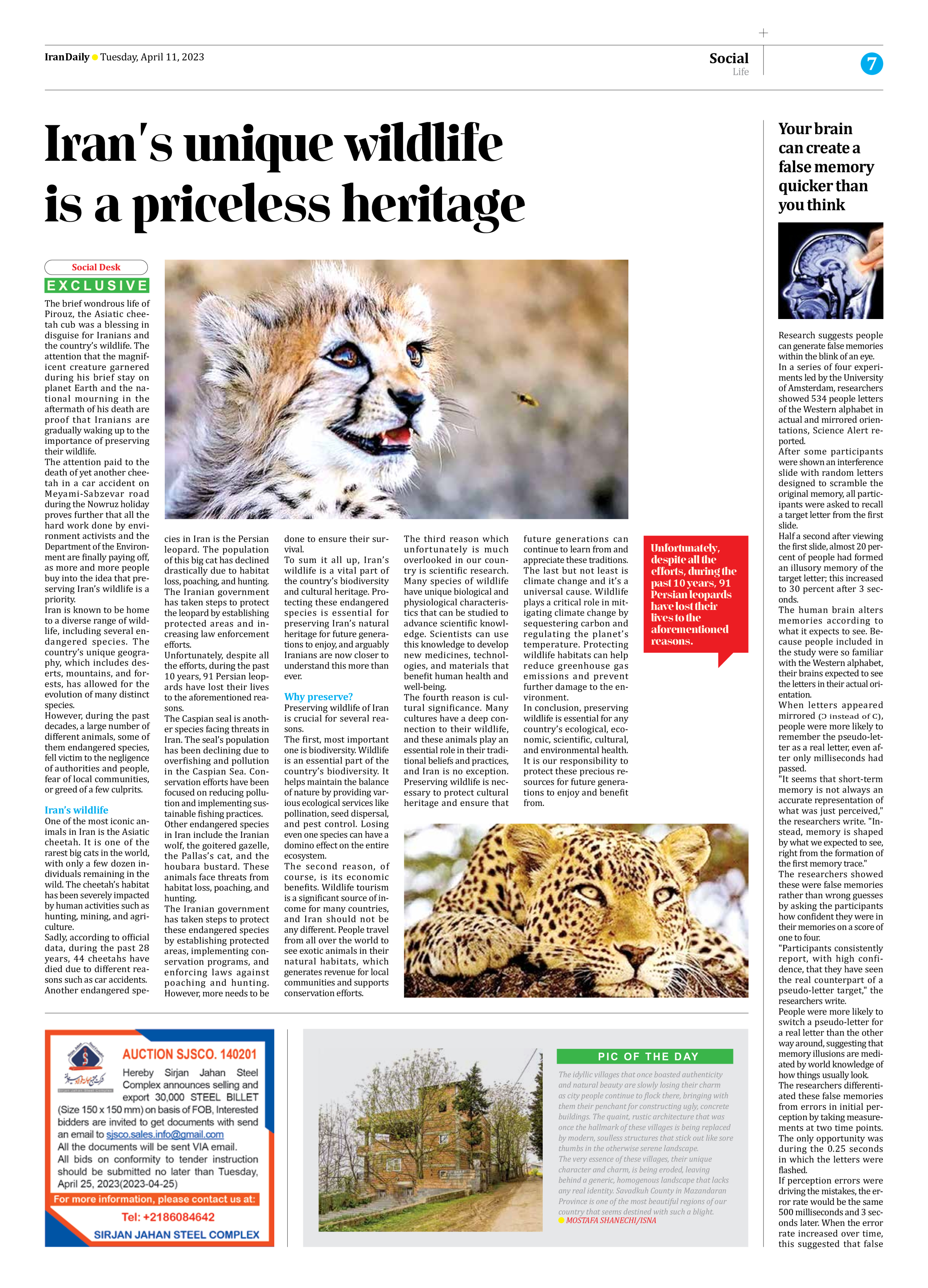
Iran’s unique wildlife is a priceless heritage
The brief wondrous life of Pirouz, the Asiatic cheetah cub was a blessing in disguise for Iranians and the country’s wildlife. The attention that the magnificent creature garnered during his brief stay on planet Earth and the national mourning in the aftermath of his death are proof that Iranians are gradually waking up to the importance of preserving their wildlife.
The attention paid to the death of yet another cheetah in a car accident on Meyami-Sabzevar road during the Nowruz holiday proves further that all the hard work done by environment activists and the Department of the Environment are finally paying off, as more and more people buy into the idea that preserving Iran’s wildlife is a priority.
Iran is known to be home to a diverse range of wildlife, including several endangered species. The country’s unique geography, which includes deserts, mountains, and forests, has allowed for the evolution of many distinct species.
However, during the past decades, a large number of different animals, some of them endangered species, fell victim to the negligence of authorities and people, fear of local communities, or greed of a few culprits.
Iran’s wildlife
One of the most iconic animals in Iran is the Asiatic cheetah. It is one of the rarest big cats in the world, with only a few dozen individuals remaining in the wild. The cheetah’s habitat has been severely impacted by human activities such as hunting, mining, and agriculture.
Sadly, according to official data, during the past 28 years, 44 cheetahs have died due to different reasons such as car accidents.
Another endangered species in Iran is the Persian leopard. The population of this big cat has declined drastically due to habitat loss, poaching, and hunting. The Iranian government has taken steps to protect the leopard by establishing protected areas and increasing law enforcement efforts.
Unfortunately, despite all the efforts, during the past 10 years, 91 Persian leopards have lost their lives to the aforementioned reasons.
The Caspian seal is another species facing threats in Iran. The seal’s population has been declining due to overfishing and pollution in the Caspian Sea. Conservation efforts have been focused on reducing pollution and implementing sustainable fishing practices.
Other endangered species in Iran include the Iranian wolf, the goitered gazelle, the Pallas’s cat, and the houbara bustard. These animals face threats from habitat loss, poaching, and hunting.
The Iranian government has taken steps to protect these endangered species by establishing protected areas, implementing conservation programs, and enforcing laws against poaching and hunting. However, more needs to be done to ensure their survival.
To sum it all up, Iran’s wildlife is a vital part of the country’s biodiversity and cultural heritage. Protecting these endangered species is essential for preserving Iran’s natural heritage for future generations to enjoy, and arguably Iranians are now closer to understand this more than ever.
Why preserve?
Preserving wildlife of Iran is crucial for several reasons.
The first, most important one is biodiversity. Wildlife is an essential part of the country’s biodiversity. It helps maintain the balance of nature by providing various ecological services like pollination, seed dispersal, and pest control. Losing even one species can have a domino effect on the entire ecosystem.
The second reason, of course, is its economic benefits. Wildlife tourism is a significant source of income for many countries, and Iran should not be any different. People travel from all over the world to see exotic animals in their natural habitats, which generates revenue for local communities and supports conservation efforts.
The third reason which unfortunately is much overlooked in our country is scientific research. Many species of wildlife have unique biological and physiological characteristics that can be studied to advance scientific knowledge. Scientists can use this knowledge to develop new medicines, technologies, and materials that benefit human health and well-being.
The fourth reason is cultural significance. Many cultures have a deep connection to their wildlife, and these animals play an essential role in their traditional beliefs and practices, and Iran is no exception. Preserving wildlife is necessary to protect cultural heritage and ensure that future generations can continue to learn from and appreciate these traditions.
The last but not least is climate change and it’s a universal cause. Wildlife plays a critical role in mitigating climate change by sequestering carbon and regulating the planet’s temperature. Protecting wildlife habitats can help reduce greenhouse gas emissions and prevent further damage to the environment.
In conclusion, preserving wildlife is essential for any country’s ecological, economic, scientific, cultural, and environmental health. It is our responsibility to protect these precious resources for future generations to enjoy and benefit from.







